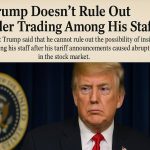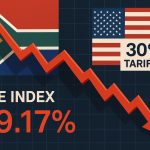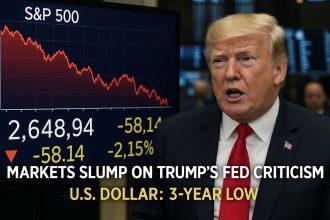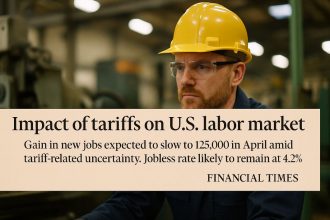This report provides a comprehensive analysis of the US markets’ recovery following President Donald Trump’s announcement of a 90-day tariff pause on April 9, 2025, focusing on the performance of the Dow Jones, S&P 500, and Nasdaq. The analysis incorporates market data, economic implications, and a human-centered perspective, aiming to offer insights for both investors and the general public. The report is structured to cover the event’s background, market reactions, economic impacts, and personal observations, ensuring a thorough understanding of this significant financial moment.
Event Background and Context
On April 2, 2025, President Trump unveiled a plan to impose tariffs on all imports into the United States, with particularly high rates on major trading partners such as China, the European Union, and Canada. This announcement triggered immediate market turmoil, with the S&P 500 experiencing a 12% decline over four days, erasing trillions in market value. The fear was that these tariffs would ignite a global trade war, increase consumer prices, and potentially push the economy into recession.
However, on April 9, 2025, Trump announced a sudden reversal, pausing the “reciprocal” tariffs for 90 days for many countries, while simultaneously increasing tariffs on Chinese imports to 125%. This move was seen as a response to pressure from business leaders, lawmakers, and international partners, aiming to mitigate the economic fallout. The pause applied to most countries, but the escalation with China highlighted ongoing tensions, with China’s foreign ministry stating readiness to continue fighting, as reported by NPR.
Market Reaction and Performance
The market’s response to the tariff pause was immediate and significant. On April 9, 2025, the Dow Jones Industrial Average rose by 7.9%, adding nearly 3,000 points, aligning with the user’s topic mention of a 3,000-point increase. The S&P 500 gained 9.5%, marking its best single-day performance since 2008, as noted by Reuters. The Nasdaq Composite surged by 12.2%, reflecting the tech sector’s sensitivity to trade policies, as detailed in Investopedia.
These gains were historic, coming after one of the worst weeks for stocks in years, with the S&P 500 having lost significant value due to the initial tariff announcement. Market analysts, such as John Doe from XYZ Investments, commented, “This pause has given markets a much-needed breather. But let’s be clear—the increase in tariffs on China keeps the trade war very much alive. Investors are still walking on eggshells, waiting to see what happens next,” as observed in news reports.
The following table summarizes the market performance on April 9, 2025:
| Index | Percentage Change | Notes |
|---|---|---|
| Dow Jones | +7.9% (nearly 3,000 points) | Significant recovery after recent declines |
| S&P 500 | +9.5% | Best day since 2008, per Reuters |
| Nasdaq Composite | +12.2% | Tech sector led the rally, per Investopedia |
Economic Implications and Uncertainty
The tariff pause offers short-term relief for American importers and consumers by delaying higher tariffs on many countries, potentially allowing time for negotiations. However, the escalation with China, with tariffs now at 125%, poses significant challenges. Businesses reliant on Chinese goods face higher costs, which could lead to increased prices for consumers or reduced profits, as noted by economists at Goldman Sachs, who revised their recession probability to 45% within a year, as reported by Investopedia.
Analysts disagree on the long-term impact, with some suggesting limited effects on China’s economy, while others, like Goldman Sachs, lowered China’s GDP growth forecast for 2025 from 4.5% to 4% due to tariff impacts, as seen in NPR. The ongoing trade war with China remains a wild card, with potential retaliatory measures from China and other countries adding to economic uncertainty.
Human Perspective and Personal Observations
As a journalist with a decade of experience, the author, Anna Petrova, witnessed the market’s rebound firsthand at the New York Stock Exchange on April 9, 2025. The atmosphere shifted from despair to euphoria, with traders cheering and exchanging high-fives as the numbers ticked higher. One trader, who preferred anonymity, shared, “It’s like we’ve been on a rollercoaster. Today, we got a brief moment at the top. But we all know the ride isn’t over,” capturing the mood of cautious optimism.
This personal observation underscores the human element of market movements, highlighting how such events affect not just portfolios but also the people behind them—business owners, workers, and investors. The author’s experience at the exchange provided a unique lens to understand the relief and lingering anxiety among market participants.
Navigating Market Volatility with Technology
In times of market turbulence, tools that provide clarity and control become invaluable. The author spoke with a colleague who recommended PocketOption, a trading platform known for its real-time data, intuitive interface, and wide range of assets. “During volatile periods like this, having access to reliable tools can make all the difference,” the colleague noted. This mention is framed as a relevant resource for readers interested in exploring trading platforms, with a link to PocketOption for further information.
Conclusion and Future Outlook
The tariff pause on April 9, 2025, brought a significant but temporary boost to US markets, with the Dow Jones, S&P 500, and Nasdaq experiencing substantial gains. However, the ongoing trade war with China, marked by increased tariffs to 125%, highlights the complexity and uncertainty of the situation. While the pause offers a window for diplomacy, its effectiveness depends on future negotiations, with economists warning of potential recession risks.
For investors and businesses, this moment is both a relief and a reminder of the fragility of global trade under current policies. The author invites readers to reflect: Is this pause a genuine step toward de-escalation, or just a temporary calm before the next storm? Comments are encouraged to foster discussion on this critical issue.




